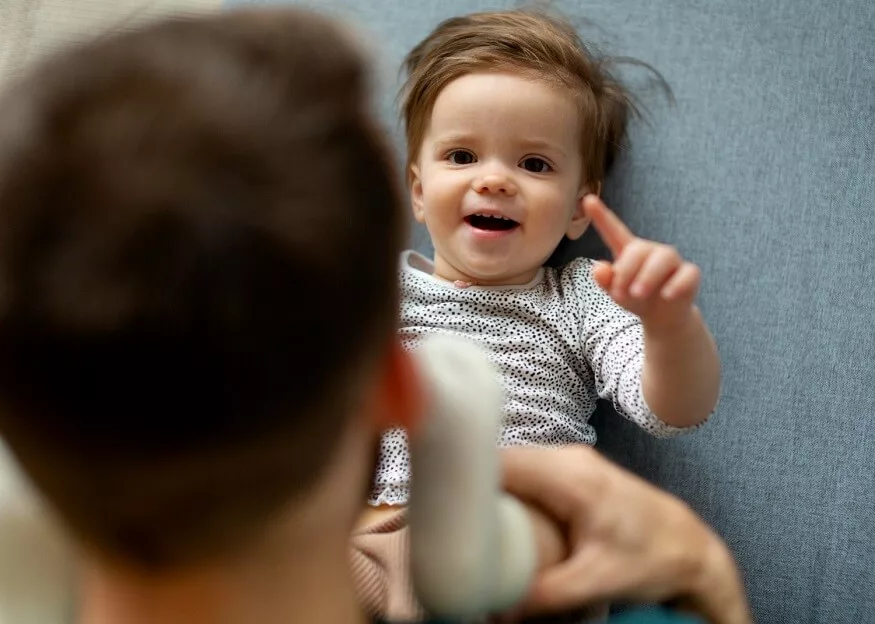Communication is a fundamental aspect of human interaction, serving as the cornerstone of relationships and societal cohesion. While adults often take their ability to communicate for granted, the journey towards effective communication begins in the earliest stages of life. Infants, from the moment they enter the world, engage in a fascinating process of communication development. This article delves into the intricate world of infant communication, exploring key milestones that shape the foundation for later linguistic and social abilities.
Communication Development in Infants
Communication development in infants is a complex and dynamic process that involves the interplay of various cognitive, sensory, and motor skills. From the very beginning, infants communicate through a combination of cries, facial expressions, and body movements. Understanding these early signals is crucial for caregivers in providing responsive and nurturing care.
One of the earliest forms of communication in infants is non-verbal, with facial expressions playing a pivotal role. Babies as young as a few weeks old can display a range of expressions, from joy and surprise to discomfort and distress. Parents often find themselves becoming adept at interpreting these facial cues, laying the groundwork for a strong parent-infant bond.
Communication with Infants
Effective communication with infants goes beyond merely responding to their cries. It involves creating a rich environment for interaction, filled with verbal and non-verbal cues that support the development of their communication skills. Engaging in activities such as making eye contact, imitating facial expressions, and using a soothing tone of voice fosters a sense of security and connection for the infant.
Infants are highly responsive to the tone and cadence of spoken language. Caregivers instinctively adopt a sing-song quality when communicating with babies, known as infant-directed speech. This melodic and exaggerated form of speech captivates infants, facilitating their engagement and encouraging the development of auditory discrimination skills.
Key Communication Milestones
- Cooing and Babbling (2-4 months): Around the age of two to four months, infants begin to produce cooing sounds and simple babbling. These early vocalisations mark the beginning of their exploration of speech sounds. Caregivers often respond with enthusiasm, reinforcing the infant’s attempts at communication.
- Gestures and Pointing (6-9 months): As motor skills develop, infants start using gestures to communicate. Pointing emerges as a powerful tool for expressing interest or indicating needs. This milestone not only enhances communication but also reflects cognitive development as infants begin to understand the power of symbols.
- First Words (9-12 months): The emergence of a baby’s first words is a momentous occasion in communication development. It is not uncommon for infants to utter simple words like “mama” or “dada” around their first birthday. These initial words often carry emotional significance, reinforcing the bond between the infant and their primary caregivers.
- Understanding Simple Instructions (12-18 months): Beyond producing words, infants gradually develop the ability to understand simple instructions. This milestone highlights the receptive language skills that underpin effective communication. Caregivers observe their toddlers responding to commands such as “wave bye-bye” or “give me the ball,” showcasing the growing comprehension of language.
- Vocabulary Expansion (18-24 months): The toddler stage is marked by a rapid increase in vocabulary. Children begin to acquire words at an astonishing rate, building their expressive language skills. This phase is characterised by the joy of discovery as toddlers eagerly name objects in their environment and attempt to articulate their thoughts and desires.
- Combining Words into Phrases (24-36 months): Around the age of two to three years, toddlers move beyond single words and start combining them into simple phrases. This represents a significant leap in linguistic ability as children express more complex ideas and engage in basic conversations. Caregivers witness the blossoming of a child’s unique linguistic style.
- Narrative Skills (3-5 years): As children enter the preschool years, their communication skills evolve to include narrative abilities. They begin to tell stories, recount events, and share experiences. This development is vital for the future development of literacy skills, as it lays the groundwork for understanding and producing written language.
- Social Communication (2-5 years): Alongside language development, social communication skills become increasingly refined. Children learn to navigate social interactions, understanding the nuances of turn-taking, sharing, and expressing empathy. Play becomes a crucial context for developing these social communication skills.
Factors Influencing Communication Development
While the aforementioned milestones provide a general framework for understanding communication development in infants and toddlers, it’s essential to acknowledge the influence of various factors on this journey.
- Individual Differences: Each child is unique, and there is considerable variability in the timing and sequence of communication milestones. Factors such as temperament, exposure to language, and genetic predispositions contribute to these individual differences.
- Environmental Factors: The linguistic environment plays a crucial role in communication development. Infants raised in language-rich environments, where caregivers engage in frequent verbal interactions, tend to achieve milestones more rapidly. On the other hand, socio-economic factors can impact the quality and quantity of language exposure.
- Cultural Influences: Cultural practices and values influence communication patterns within families. Some cultures may emphasise verbal communication, while others may place greater importance on non-verbal cues. Understanding and respecting these cultural variations is essential for effective communication with infants.
- Responsive Caregiving: The responsiveness of caregivers to an infant’s cues and attempts at communication is a fundamental factor. Infants thrive in environments where caregivers consistently respond to their needs, fostering a sense of security that is essential for communication development.
The journey of communication development in infants and toddlers is a captivating and intricate process, shaped by a myriad of factors. From the earliest cries and coos to the emergence of complex language and social communication, each milestone contributes to the foundation of a child’s communicative abilities. Caregivers play a crucial role in this journey, providing the support and stimulation needed for infants to flourish.
EuroSchool understands and celebrates these key communication milestones not only enhances our appreciation for the wonders of early development but also informs practices that promote healthy communication habits. As we witness the unfolding of a child’s linguistic and social abilities, we become witnesses to the remarkable journey of human communication, a journey that begins in the cradle and continues to shape our interactions throughout life.










